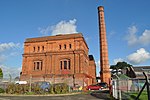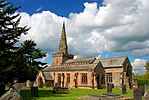Bladon Castle

Bladon Castle is a folly, partly converted into a country house, located some 600 yards (550 m) southwest of the village of Newton Solney in South Derbyshire, 1 mile (1.6 km) northeast of Burton-on-Trent and close to the point at which the River Trent forms the boundary with Staffordshire. The castle was originally built as a folly in a Neo-Gothic style by the architect Jeffrey Wyattville for Abraham Hoskins of Burton-on-Trent, grandfather of George Gordon Hoskins. Designed to give the appearance of a large castle with battlements, the structure was in reality little more than a single long wall.It was subsequently partly converted into a house. The building lies within the grounds of Bladon House School, and is now in a semi-ruinous state.
Excerpt from the Wikipedia article Bladon Castle (License: CC BY-SA 3.0, Authors, Images).Bladon Castle
Burton Road, South Derbyshire
Geographical coordinates (GPS) Address Nearby Places Show on map
Geographical coordinates (GPS)
| Latitude | Longitude |
|---|---|
| N 52.8226 ° | E -1.6009 ° |
Address
Cliffe Lodge
Burton Road
DE15 0TG South Derbyshire
England, United Kingdom
Open on Google Maps








